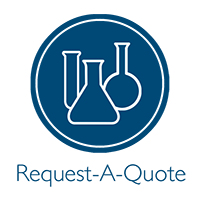This method is applicable for determining emissions of hydrogen halides (HX) [HCl, HBr, and HF] and halogens (X2) [Cl2 and Br2 ] from stationary sources. Sources, such as those controlled by wet scrubbers that emit acid particulate matter, must be sampled using Method 26A.
Samples are collected non-isokinetically using Method 26 train consisting of a heated probe and filter and a series of 30mL (midget) impingers. The filter is typically Teflon in a mat configuration. If the source temperature is above 210°C (410°F), a quartz filter can be used because the Teflon will begin to degrade at that temperature. A knockout impinger (for moisture) may be used which is placed prior to the series of impingers. The 1st and 2nd impingers are filled with 15mL of 0.1N H2SO4. The 3rd and 4th impingers are filled with 15mL of 0.1N NaOH. A final impinger or drying tube contains silica gel.
The filter collects particulate matter which includes the halide salts and is not typically recovered or analyzed. Note the methods calls for the use of a Teflon filter holder. New Teflon has been noted to release HF. Condition by heating any new Teflon filter holders prior to using them for sampling.
Please note, each sampling train will have two fractions. Typically, hydrogen halides (HCl, HBr, HF ) are analyzed from the acidic impinger fraction while halides (Cl2, Br2, etc.) are analyzed from the alkaline impinger fraction. Note that F2 cannot be determined using this method.
The contents of the H2SO4 impingers and knockout impinger are combined in a polyethylene bottle. The impingers and connecting glassware are rinsed with deionized water and combined with the impinger contents. The contents of the NaOH impingers are combined in a polyethylene bottle. The impingers and connecting glassware are rinsed with deionized water and combined with the impinger contents. Sodium thiosulfate must be added to the combined NaOH sample to ensure the complete reaction to the halide ion. An equivalent of 0.7 mg per ppm of halogen in dscf (dry standard cubic feet) of stack air is the amount to add as cited in the method.
Each fraction (H2SO4 and NaOH) is analyzed by IC and each is analyzed in duplicate. Each measurement must agree within 5% of the mean value to be considered valid. Otherwise, the samples must be reanalyzed.
No Obligation Quotation for Analytical Services
If you would like us to provide a quote for laboratory analysis, just provide us with as much information as you can about your project (the more, the better) and we'll provide you a quote via email. As you are searching or browsing our Analytical Guide, you'll see the Request-A-Quote icon... just click on it to start the request process.
| Hold Times, Preservatives, Preps, Collection, Analytical & Documentation | |
|---|---|
| Holding Time: | None specified in method but 4 weeks from sampling to collection is required for Method 26A. |
| Preservatives: | Sodium thiosulfate addition to NaOH impingers (0.7 mg per ppm of halogen in dscf). |
| Required Preps: | Teflon or quartz filters |
| Collection Method: | Method 26 sampling train following Method 26 procedures. |
| Analytical Methodology: | Ion chromatography using a conductivity detector |
| Documentation: | |
| Analyte | Formula | CAS Number | Detection Limit | |
|---|---|---|---|---|
| Hydrogen bromide | HBr |
10035-10-6 |
0.1 |
ppm |
| Hydrogen chloride | HCl |
7647-01-0 |
0.1 |
ppm |
| Hydrogen fluoride | HF |
7664-39-3 |
0.1 |
ppm |
| Bromine | Br2 |
7726-95-6 |
0.1 |
ppm |
| Chlorine | Cl2 |
7782-50-5 |
0.1 |
ppm |
* The analytes and detection limits listed for each method represent the typical detection limits and analytes reported for that particular method. Keep in mind that analyte lists may vary from laboratory to laboratory. Detection limits may also vary from lab to lab and are dependent upon the sample size, matrix, and any interferences that may be present in the sample.